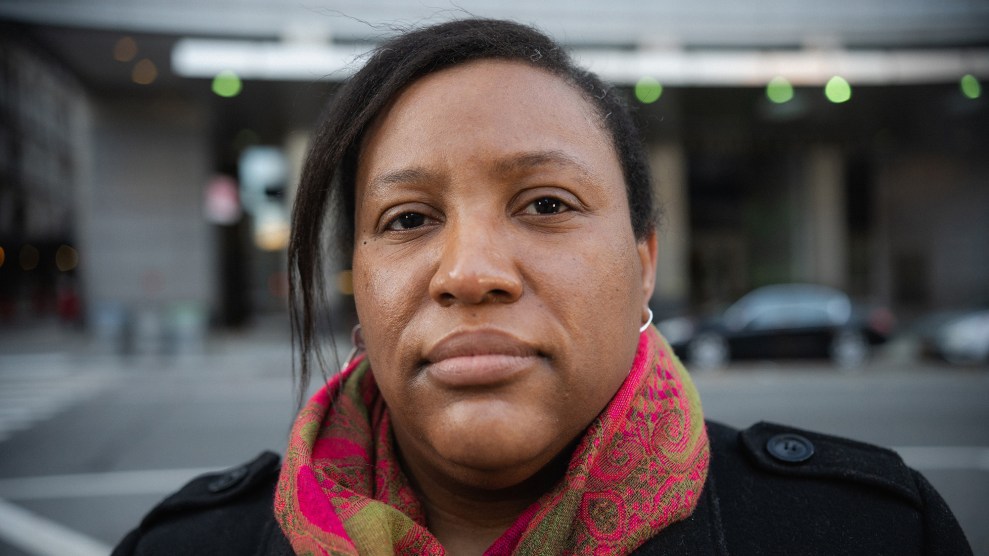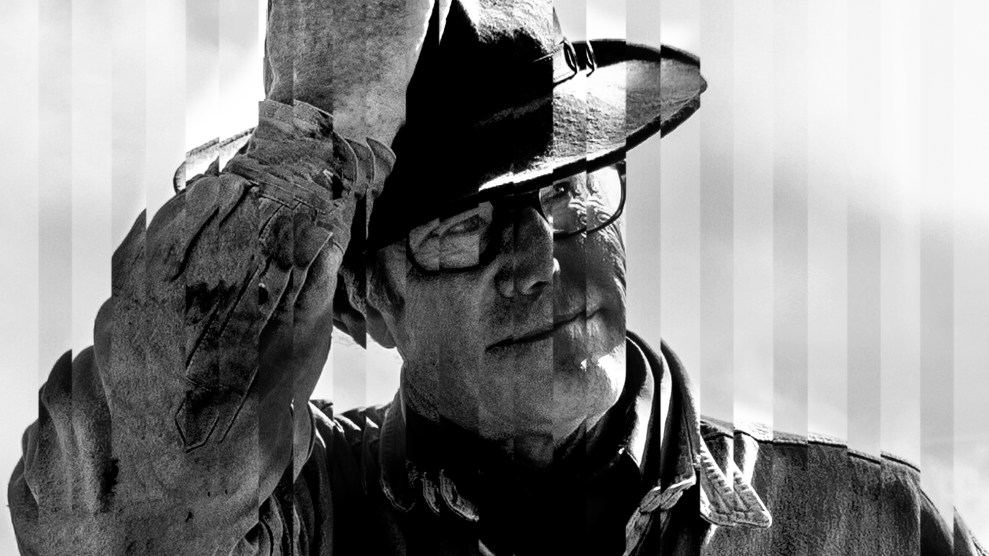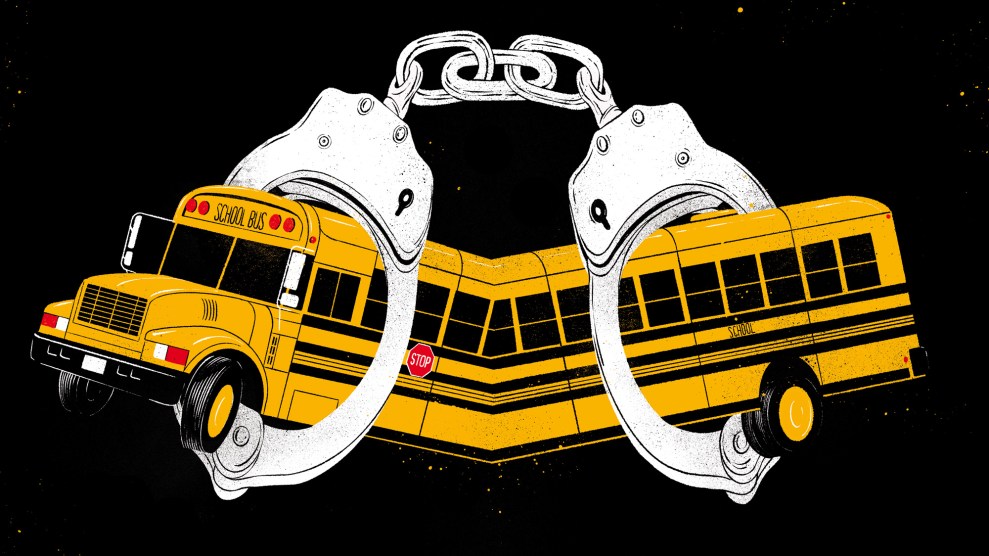It’s a habit of David Moore’s, dropping profound quotations into conversation—sometimes it’s the Bible; sometimes it’s the Dhammapada, a Buddhist text. On this particular day, he’s referencing Malcolm X. “Equality is the opportunity,” the Sacramento State University finance professor recites on one of our recent Zoom calls, “to develop all of our dormant potential, all of our dormant capabilities.”
Moore is a bald and clean-shaven 46-year-old, cerebral, his speech often punctuated by a slightly furrowed brow. He is reflecting on his role as an educator, but he is also leaning on the more-than-academic, the more-than-intellectual connection he feels with the civil rights leader. Moore, who says he is the only tenured Black professor in the College of Business Administration, has recently felt the connection on a visceral level. Ever since an incident with another professor two years ago, Moore has been fighting—fighting for justice, fighting for recognition from his university, fighting to bring what happened to people’s attention because, he says, “the public won’t be fooled.”
The incident went like this: At the September 10, 2018, meeting of Sacramento State’s Student Investment Fund, a class–club hybrid where students gained real-world experience managing an investment portfolio with support from their professors, there was pretty good turnout—about 30 students. Some were returners, hoping to expand their investment knowledge. For others, what occurred that day would be their first experience with the fund.
Moore had developed the fund’s trading strategy and been one of its faculty mentors for several years. But in 2018, due to “leadership disagreements” and “schedule pressure,” he says he left advising responsibilities to another finance professor, Anna Vygodina, though he expected to continue working with the group as an informal adviser.
For more articles read aloud: download the Audm iPhone app.
Around 3 p.m., as the meeting was starting, Moore headed to the back of the classroom. When he slid into a seat next to Sanjay Varshney, another finance professor who had been invited by Vygodina, Moore discovered he was no longer welcome.
The following, unless otherwise noted, is Moore’s recollection of what happened next; Varshney and Vygodina did not return requests to comment.
“Soon as I walked in,” Moore says, Varshney asked him, “What are you doing here?”
“I’m here to support the students,” Moore replied.
“Are you a faculty adviser?” Varshney asked.
“I don’t know what titles we’re throwing around these days,” Moore said. “I do know I developed all the materials that are about to be presented.”
Students started to glance toward the chatter coming from the back of the room.
“I think you should leave,” Varshney told Moore.
Moore ignored the suggestion. Varshney then interrupted the class and announced, “Dr. Vygodina, I’d like you to halt the meeting until Dr. Moore leaves.” He added, “This man shouldn’t be here,” according to a statement written shortly after the incident by one former student who was present.
“It almost seemed like a joke,” she wrote.
Students tell me Vygodina said nothing, while the class sat in confused silence. “I was just sitting there going, Why are they trying to kick a professor out of a class?” Joshua Cox, another former student who was at the meeting, recalls.
Moore refused to leave. “Hey, are you going to remove me?” Moore asked Varshney.
That’s when Varshney exited the class, phone in hand.
Suddenly, there was a police officer in the room, says Taylor Comer, another former student. “Is there a Dr. Moore here?” the officer asked, leaning into the classroom.
“We’re like, Did this guy really just call the cops?” Comer tells me.
Stay calm, stay calm, Moore told himself. He had been racially profiled by the police before, and he knew his life could be in danger. Just six months earlier, police had shot and killed Stephon Clark, a 22-year-old Black man, in his grandmother’s backyard, just about eight miles from Sac State. Channeling his mother, Moore stayed composed. “I’m right here,” Moore responded and headed into the hallway.
University officers carry 9 mm handguns, as well as other “less-lethal” weapons, according to Mark Iwasa, the force’s chief. Two officers were present that day. Officer Andrew Miller spoke with Moore, who explained his history with the Student Investment Fund, and that he had notified Vygodina that he would be attending the meeting. Officer Anthony Martinez chatted separately with Varshney. After speaking with the officers, the two professors agreed to settle the dispute with the dean at a later time. (Both Miller and Martinez declined to be interviewed.)
As the two professors headed back toward the classroom, Varshney turned to Moore and said, “No hard feelings.”
For Moore, and even for others present, that was hardly the reality. “Since I started studying at Sac State I always felt this University was an inclusive place, but this week that was not how I felt,” the former student who was present wrote in her statement. “If Dr. Varshney can treat a fellow faculty member this way, that sends a message to all students that were present at the meeting that disrespectful and irrational behaviors are acceptable inside this school.” (The former student did not respond to a request for comment, but asked that her name not appear in this article.)
Why Varshney called the cops that day is still not clear—Moore tells me he doesn’t know why Varshney did what he did—but what happened is clear: One professor called in armed police officers on his colleague, a Black man, in his place of work to respond to a situation that did not require any police response whatsoever.
“It got to the point of calling the police on a Black professor, unnecessarily,” Moore tells me, adding, “I can’t call him a racist. I can say calling the police on me, that’s clearly racist.”
Beyond fearing for his life, beyond the anger at his colleague’s “attempt to embarrass [him] in front of 30 students,” Moore, over the days, months, and years that followed, couldn’t shake the hard feeling of being excluded from a group he cared deeply about and that he helped build. “Why am I excluded? That’s the question that kept going through my head,” Moore says.
What happened next, though, would end up making the situation even worse for Moore. Following the police killings of Black men and women this past summer, Sac State and the system of which it is a part—the California State University, the country’s largest four-year university system—offered a public commitment to racial justice. Despite those promises, Moore has been dismissed and what happened to him has been downplayed or ignored. “I get tired of seeing them talk about how they care about diversity and inclusion,” Moore says, “but they won’t acknowledge this incident.”
Moore reflects on a startling email he got one day in May last year. Addressed to the Black Staff and Faculty Association, it was unrelated to what happened at the Student Investment Fund, but it nonetheless appeared to speak to his experiences at the university:
I apologize in advance, but I am no longer interested in doing anything for this University other than what I’m paid to do. The Administration has made it clear to me that diversity and inclusion means nothing unless it is for their benefit. Going forward, I hope this group really takes a hard look at how African-Americans are treated on this campus.
It was from, of all people, the director of equal opportunity in the university’s human resources department, William “Skip” Bishop, who is also Black. While it also remains a mystery what prompted the email—Bishop declined requests for comment—Moore still felt betrayed. Months before this email, Bishop had been the one to review the details of the September 10 incident and essentially decided the administration would not act on it. Reading the note, Moore felt stuck—where was this outrage then?
“I want the whole world to know [what] happened,” Moore tells me in one of our many conversations this summer and fall. “I want the world to know how the university responded and see the flaws in their response. And the hope is with the public acknowledgment of this, there’ll be some real change.”

Moore’s case is, of course, just one note in a symphony of congruent experiences in the largely white world of academia, well beyond the confines of Sacramento State. After all, notes Hakeem Croom, president of the Black Staff and Faculty Association at Sac State, racism on college campuses, a lack of representation, and other related dynamics are all “a byproduct of the origin of higher education in this country.” As Northwestern University professor Leslie M. Harris details in a 2015 piece for the Conversation, a nonprofit newsroom that publishes articles by academics, enslaved Black people literally built many of this country’s universities; students and staff at one time brought slaves with them to campus; and up until the mid-20th century, Black students were barred from attending universities in the South and limited by quotas in the North.
CSU has its own unique and, at times, turbulent history with race. In 1961, the board of trustees tapped Buell Gallagher, then the president of the City College of New York, to serve as the system’s first appointed chancellor. Gallagher, who was white, was a civil rights scholar: In his Columbia University Ph.D. dissertation titled American Caste and the Negro College, he considered how to improve American attitudes around race, arguing, “In the widest and most inclusive sense of the term, education is the best answer to the challenge of caste.” Gallagher was also a proponent of free speech protections for communists and Marxists, according to Donald R. Gerth’s The People’s University, a history of the CSU system. As Gerth chronicles, Gallagher’s appointment was largely celebrated by faculty and students, but met with vehement opposition from right-wing groups which “launched a campaign of accusations, letter-writing to the governor and other public officials…and attacking Gallagher in the media.” Less than a year after he took the job, Gallagher resigned.
Though Gallagher didn’t have a chance to accomplish much during his short tenure, CSU did establish grievance processes within the system shortly after his appointment. Even after Gallagher’s exit, Gerth notes that in the 1960s, CSU became an early adopter of affirmative action policies, both for students and faculty. And in the late ’80s, to boost faculty diversity, CSU launched a program “to encourage completion of doctoral programs in fields where women and minorities were most severely underrepresented at the time—the sciences, mathematics, engineering, and computer science,” Gerth writes.
Likely as a result of this legacy, today Sac State is one of the nation’s most diverse campuses; it has been lauded for the makeup of its student body by the media and prides itself on a “faculty that is growing more diverse each year.” At more than 30,000 students, the school’s enrollees are 34 percent Hispanic/Latino, 26 percent white, 19 percent Asian, 6 percent Black, and 1 percent Pacific Islander.
But its faculty offers a stark contrast: 62 percent white, 12 percent Asian and Pacific Islander, 7 percent Latino/a/x, 5 percent Black, and about 1 percent Native American, according to 2019 CSU records analyzed by the faculty union. Among tenured faculty across the CSU system, the trend holds: That same year, 62 percent of tenured faculty were white, 20 percent were Asian, 9 percent were Hispanic or Latino, 3 percent were Black or African American, and less than 1 percent American Indian or Alaska Native, according to CSU.
Still, the numbers are even worse at the national level, where 75 percent of full and associate professors (titles typically associated with being tenured) are white, and where Black and Latino professors are underrepresented.
After the events of this year—a contentious election, a pandemic that disproportionately impacts communities of color, and police shootings that have focused the country’s attention on state violence targeting Black people—there has been “without question” a surge in interest in discussing race in higher education, says Richard Reddick, the inaugural associate dean for equity, community engagement, and outreach for the College of Education at the University of Texas at Austin. “It’s sort of the perfect storm of all these issues coming together at exactly the same time,” he says. “It’s unavoidable.”
While in the past, schools may have shown “cursory engagement” with diversity, equity, and inclusion, Reddick is now hearing from institutions that want to move to “the next level”—past awareness, on to action. Universities are beginning to grapple with their racist histories, evaluate curricula, and make an effort to support and retain students and faculty of color. While universities have a long way to go, “what’s happened over the last several months,” he says, “has really pushed the agenda forward.”
Part of that work is happening in public. In June, #BlackintheIvory, a hashtag first shared by two Black women in communications research, exploded on Twitter, with thousands of academics describing experiences of being mistaken for graduate students, other Black staff members, or “the help.” One scientist whom I spoke with in detail in June tweeted that on her first day of work a colleague “physically blocked” her from getting her mail in the faculty mailroom, threatening “to call the police because they thought [she] was a student trying to steal mail.”
“So many Black faculty, as well as staff, graduate students, and undergraduate students, are walking around with an incredible amount of racial trauma,” says Shardé Davis, an assistant professor in the Department of Communication at the University of Connecticut who first conceived of and tweeted the hashtag, along with UT-Austin doctoral student Joy Melody Woods. “Some of that trauma is from years past…but some of that trauma is also from experiencing anti-Black racism in the academic work environment at university campuses across the nation.”
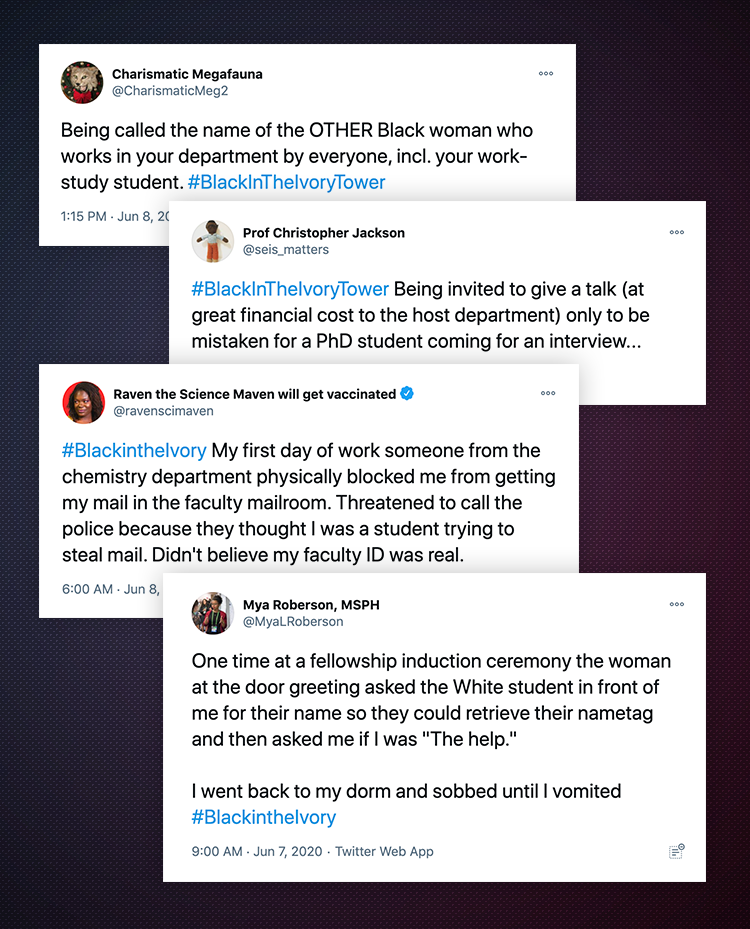
Reddick emphasizes that in order to see lasting change, institutions must have metrics in place to measure their progress—and should expect to commit to change in the long term. He says it’s like getting exercise: “If you go to the gym one day after the holidays, well, you’re gonna be sore first of all, and you’re not going to see a whole lot of results. But if you commit to doing the work over time, you will see results.
“It has to be a sustained, demonstrable, measurable commitment,” he adds.
Sacramento State, for its part, has recently pledged to develop an anti-racism campus plan, provide anti-racism training, and “support faculty and departments in building anti-racist curriculum and anti-bias pedagogy,” among other actions. In a statement to Mother Jones, a university spokesperson elaborated that “its leaders understand that creating an antiracist, inclusive environment for all members of the campus community requires more work. Even as we build upon our commitment to this mission, we know that negative or even traumatic incidents not aligned with our values are possible. We also understand our responsibility to address and prevent such occurrences, in compliance with the law.”
When I ask Croom how he would characterize Sac State’s commitment to diversity, he says it is “imperfect, like a lot of other schools.” He’s optimistic about change, but recognizes it will require learning “how to hold the institution’s feet to the fire.”
“It’s not going to happen overnight,” Croom adds. “This is 400 years of inequity we’re talking about.”

Interviews with former Black professors at Sac State, as well as emails and documents obtained by Mother Jones, speak to the larger challenges facing Black staffers and put into question the university’s ability to support a diverse faculty, even as the school pledges to address discrimination within the institution. Indeed, two former professors of color I spoke with told me that they left the business school in part because of racism they experienced on the job.
One former professor, whom I’ll call Jamie, joined the faculty in the late ’90s. They say things “got really bad” when they decided to apply for early tenure. Jamie, who requested anonymity due to professional concerns, says the process “came down to nitpicking” their achievements. As Jamie recalls, the department chair, who was Chinese, complained about the journals in which their work was published and that their student evaluations were a fraction of a percentage below those of their peers. His letter rejecting the tenure request was “six or seven pages long,” Jamie recalls. The chair, who has since passed away, “would give his [phone] numbers out to the Asian faculty, but nobody else,” Jamie says, and he would invite Chinese students to his home, but not others. “I remember one time, we were interviewing somebody who was Korean,” they recall. “And I said, ‘Well, you know, his last name sounds more Chinese than Korean.’ He said, ‘Well, we used to own [his] people.’”
“It was that kind of thing—little comments that would just kind of get thrown out,” Jamie says. “It’s almost like you don’t think about it at the time, but later on, you’re going, Wait, what did you mean by that?”
After a few more years, Jamie left the university. They were tired of the toxic work environment. “It got to the point where it was really, really hard and uncomfortable to come on campus. Because you didn’t feel like you belong there,” Jamie tells me. “And the way people treated you, you didn’t want to be there.”
Terence Pitre, a former associate professor of accounting at Sac State, stayed at the university only a year. In 2016, shortly after he was hired, he was tapped by the business school dean to head a search committee to fill an associate dean position. Pitre wasn’t tenured at the time, so several of his committee peers were, on paper, senior to him. He thinks that ruffled some feathers, especially because he is Black. “It’s just an interesting dynamic when you actually have power as an African American in academia,” he says. “It can rub some people the wrong way.”
During the process, he recalls a colleague on the committee “effectively stalled out the search” by being uncooperative. “On top of that,” Pitre says, “he just started to attack me every time we had a meeting—sending out these just blistering emails to the dean and to the committee saying what an awful person I was and how I was manipulating the department and how I was trying to destroy the department and the school.” When Pitre refused to divulge information about the search to another tenured colleague who was not involved in the hiring, he says, she stopped speaking to him. Another professor not on the committee, he says, tried to tell Pitre how the process ought to be run: “At one point I felt the ‘advice’ was more of a threat than advice since it was repeated three (3) times accompanied with a long and lingering stare,” Pitre wrote in an email to the university’s human resources department in 2017 outlining the various incidents.
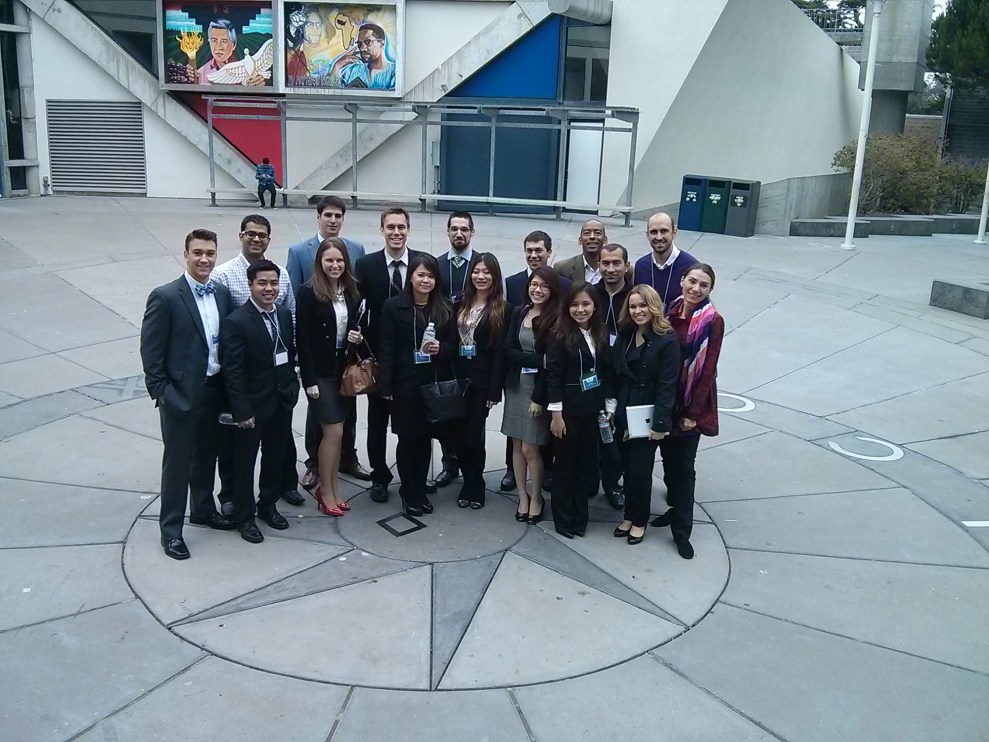
According to emails shared with Mother Jones, Pitre was then directed to Don Taylor, an administrative staff member then serving in the Division of Academic Affairs. Pitre says Taylor, who is Black, listened to his concerns but never formally addressed them. “After that meeting, it was, Okay, well, you’ll be fine. Don’t worry about it…and just kind of brush it under the rug,” Pitre says. “At the time, I didn’t quite get it. But then I realized [Taylor’s] whole position was to basically extinguish whatever fire was burning, and not have me file any formal complaint.” Nothing more came from Pitre’s memo. (Taylor did not respond to a request for comment.)
Pitre, who has worked for at least eight universities over his career, says he’s found this kind of response “fairly typical” in academic spaces. “Persons of color are strategically placed to buffer and suppress complaints. It just goes with the territory of being a person of color in a professional environment, unfortunately.” He left Sac State in 2017 in part because of the way he was treated by his peers.
Data from across the CSU system indicate that the experiences of Jamie, Pitre, and Moore are not outliers. According to Terry Scott, a representation specialist with the California Faculty Association, CSU’s faculty union, roughly five years ago CSU had about 14 open discrimination grievances. As of this fall, it had over 100 open discrimination grievances, though that number includes cases of alleged discrimination based on factors other than race.

Not every injustice on campus gets documented. In Moore’s case, he says the police call followed a series of microaggressions from his colleagues: He’s received unusual scrutiny over his class syllabus; he says a former dean told him, “I don’t like when people play the race card”; shortly after he was hired in 2011, a colleague implied that Moore was selected for the job to boost the college’s diversity numbers. (“Well, you know why they hired you.”) Moore, in fact, was more than qualified: He earned an engineering degree from Purdue University at just 19 years old, followed by an MBA from Arizona State University, and a Ph.D. in finance from the University of Tennessee. Before turning to teaching, he worked as an engineer at several Silicon Valley semiconductor startups and at Motorola. “I got out of the dot-com rat race to slow things down,” he says. Compared to that industry, he says, “professor life is pretty relaxed.”
Even still, after the university’s handling of the confrontation with Varshney, Moore considered leaving Sac State.
From the outside, it’s still nearly impossible to fully understand what happened that September day and in the months following; neither of the two other faculty members present at the meeting and none of the half-dozen administrators I reached out to who were involved with the grievance process were willing to speak with me. Still, the paper trail indicates the school has done nothing to amend the situation.
A little more than two weeks after the incident with the Student Investment Fund, on September 27, 2018, Moore and the faculty union filed a grievance with the school, alleging that he was discriminated against and his life was effectively put at risk. “Dr. Varshney’s decision to call the police on his African American colleague raises concerns about campus climate and safety for Black professors on campus,” the grievance reads. “The national climate regarding police and African Americans, as well as non-Black persons deciding to unilaterally police Black people in their daily movements, demands this incident be taken as more than a simple dispute.”
About a month later, on October 23, 2018, representatives from the university, the faculty union, and Moore held what would be the first of two grievance meetings. Moore presented an extensive report he’d prepared, 54 pages in all, in which he detailed the context of the incident, outlined remedies, and shared written testimony from four students who witnessed it.
“Dr. Varshney’s behavior was unacceptable and inappropriate,” the former student who was present wrote, according to Moore’s presentation. “In my opinion,” wrote Joshua Cox, according to the presentation, “Dr. Varshney seemed to instigate the event and pose the greatest disruption as many members of the SIF just wished to continue with the meeting and resolve the issue at a later time.” And in an email to the dean voicing his support for Moore, Taylor Comer wrote, “If we bar Dr. Moore are other professors also not welcome?…Does excluding Dr. Moore mean students can bar other students?”
The university officially denied Moore’s grievance request on December 3, 2018. It determined that Moore was not put in any danger and that there wasn’t sufficient evidence to prove the incident was in fact racially motivated. VeRonica Busby from the Office of Faculty Advancement cited previous “tension” between Moore and his colleagues: Varshney and Moore, for instance, had previously clashed when Varshney was serving as dean, with Moore alleging that Varshney treated him unfairly—for instance, Moore says he was passed over for recognition at awards banquets. And, Busby wrote, Vygodina, who had a personal relationship with Moore that ended in 2012, had “denied [Moore’s] request to support the purchase of his book to the SIF students.” (Moore’s book, Student Investment Fund in a Book 6e, is a guide to running a SIF; emails show Moore asked Vygodina to cite his book in her presentations and suggested that if she continued to use material from the book she recommend or require it for the course. Moore notes he donated free copies to the group, and a supervisor confirms Moore did not try to force students to buy it.)
“Based upon the tension (perceived or otherwise) between the Grievant, Dr. Varshney and Dr. Vygodina coupled with the Grievant’s decision not to leave the meeting when asked,” Busby wrote, “it is reasonable to conclude that Dr. Varshney deemed the situation as disruptive. Thus, he called the police regarding the conduct of his colleague.” (Busby did not respond to a request for comment.)
According to Moore, there were a number of problems with the school’s investigation. First, it is unclear how many students the school interviewed about the incident; of the three students I spoke with, none was contacted by anyone from the school. And if investigators spoke with Varshney or Vygodina, it isn’t included in the paperwork Moore shared with Mother Jones.
In fact, in its final report, the school primarily relies on testimony from just one source: Marty Wilson. At the time, Wilson was the faculty supervisor to all three professors involved. Wilson told university investigators that she vaguely recalled a conversation she had with Varshney about calling the police if Moore attended the SIF meeting—which she “may” have said was “ok” to do if Moore was being disruptive, according to Busby’s written response. To Moore, this indicated that the police call was “pre-planned”—further evidence of discrimination. “Whatever got resolved after [the incident] could have got resolved before the police were called,” he says. “And it wasn’t. I was set up.” (Wilson did not respond to a request for comment.)
Moore also points to another curious detail about the investigation: In typical circumstances, if a grievant alleges discrimination, the case is put on hold until after the university’s Office for Equal Opportunity can take a look at it. But in Moore’s case, Busby formally rejected Moore’s grievance two weeks before that office’s determination regarding discrimination was released, on December 17, 2018.
The head of the Office for Equal Opportunity, Skip Bishop, ultimately decided that the incident with Moore did not constitute discrimination, but no one who was willing to speak with me could provide a clear answer about this timeline discrepancy.
Moore appealed the denial, kicking his complaint up to the CSU system. In February 2019, CSU denied the appeal, noting Moore’s safety was not in jeopardy because “[u]niversity police are well trained and exist to ensure the safety of the campus community.” Although CSU admitted the timing of the Office for Equal Opportunity determination was a “technical violation,” it also claimed, basically, no harm, no foul. (The CSU chancellor’s office declined a request for comment, saying they are unable to weigh in on “a personnel issue.”)
Over the year and a half since, the school has still not publicly addressed what happened to Moore. The appeals process may finally come to a conclusion with an arbitration hearing over the coming months. If Moore wins in arbitration, it may bolster his case if he chooses to take legal action against the school.
According to Terry Scott, the union representative who is helping Moore in his grievance process, it’s not unusual for the university to find itself faultless when faculty members complain of discrimination and racial profiling. “There’s always an excuse,” he says. “But it doesn’t change the fact that that Black people—faculty, staff, students—are scrutinized for the color of their skin and walk around with targets on their back.”
What was unusual, though, was the May 2019 email Bishop sent to the entire Black Staff and Faculty Association, in which he wrote, “Diversity and inclusion means nothing [to the administration] unless it is for their benefit.” He sent it just five months after determining on behalf of the university that calling the police on Moore was not a discriminatory act.
Moore was stunned by the missive. Whether or not the email had anything to do with Moore’s case, Bishop’s message was clear: Black people aren’t being treated fairly at Sac State.
In hindsight, Moore sees the decision in his case as Bishop simply “doing his job.” But, in an echo of Pitre, Moore laments, “The grievance process isn’t about justice. It’s about sweeping stuff under the rug so you can say, ‘We’re compliant.’”

In early May, the wife of a Sac State economics professor, a white woman, was caught on camera referring to her Black neighbors with a racial slur. “That left a bad taste in a lot of people’s mouths,” says Croom, from the Black Staff and Faculty Association.
The video went viral, prompting an email from the university’s president, Robert Nelsen, who called it “very disturbing,” writing to staff and students, “we absolutely do not condone this sort of language or behavior.” The incident was a “personnel matter that the University is investigating,” the president wrote, “and we will not address it again publicly.”
If things had gone differently this past summer, that might have been the end of it, another incident swept under the rug. But later that month, after the brutal police killing of George Floyd, Nelsen wrote another email, which again condemned what had happened with the professor’s wife, as well as racism more broadly, and pledged to combat discrimination on campus. The email was, presumably, intended to be a note of reassurance. But for Moore, it didn’t sit right. All he could think was, Wait a minute, if you can call that out as wrong, what about my case?
Moore, according to emails he shared with Mother Jones, wrote back to Nelsen, asking if he remembered his case. “The only tangible difference regarding what happened in the Student Investment Fund meeting,” Moore wrote, “is that a student didn’t record and a video didn’t go viral.”
Nelsen wrote back, “Of course, I remember your case. I was thinking of it when I wrote the [email] below…I hope that the actions outlined in the memo can help us heal and create a safe campus.” (Nelsen declined to speak with Mother Jones.)
To Moore, it felt like just one more dismissal.
By the time Moore and I met in San Francisco at the end of August, he was exhausted. He had come down from Sacramento to escape the smoke from nearby wildfires and suggested we meet in Malcolm X Plaza at San Francisco State University, a sister school of Sac State.
It was four days after a police officer in Kenosha, Wisconsin, shot Jacob Blake, a 29-year-old Black man, in the back seven times. Moore said the news was a reminder that his case could also have ended in violence. “Had I overreacted they probably would have shot me too,” Moore told me. “Had it been my brother or my father, they would have been dead.”
Moore also reflected on all the many hours he’d lost over the past two years—to appealing to the administration, to talking to reporters from the school paper, then local papers, and now me, over the phone and on Zoom. He talked about how he had suffered professionally for it. “It’s sucked away time and energy from a very important part of the job of a professor, which is to produce research.” Moore notes he hasn’t published any research papers since the incident.
While Moore briefly created a new club called Inclusive Quantitative Student Investment Fund for students interested in investment in an “inclusive financial analysis environment,” he eventually went back to running the Student Investment Fund, which has since officially become a three-credit-hour elective class.
While I didn’t fully appreciate the setting at the time, we were sitting on benches under a mural of Malcolm X with the words, “Our objective is complete freedom justice and equality by any means necessary.”
Part of the reason Moore stays at Sac State and continues to seek a response from the university, even at the expense of his career, is a sense of duty to progress. “If I don’t do it, then when? Then who?” he says. “There are people that came before me like John Lewis that took the ice cream on the head and the cigarette burn in the back while seated at a restaurant. Those before me sacrificed and didn’t just leave.”
“My inner voice says don’t let it go yet. Don’t let it go.”
This article has been updated to obscure the identity of a former student.

